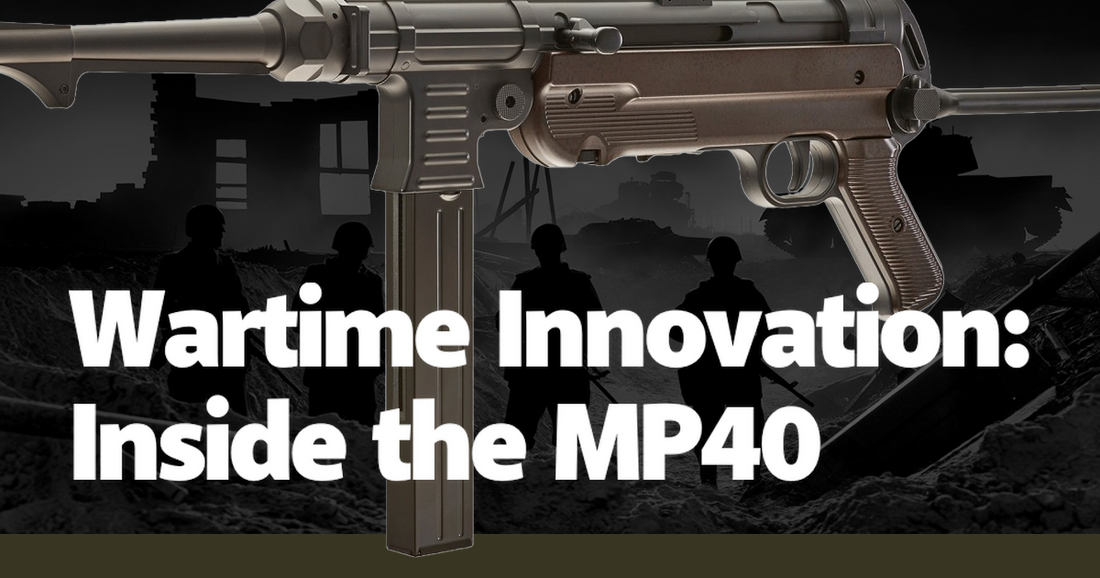The MP40, known colloquially as the "Schmeisser," is an iconic submachine gun that became a symbol of German military might during World War II. This weapon, with its sleek design and reliable performance, was a crucial innovation in wartime technology. Introduced in 1940, the MP40 was designed for close-quarter combat, offering a significant advantage in the urban and trench warfare that characterized much of the conflict. Its development was driven by the need for a lightweight, easily mass-produced weapon that could be used by paratroopers, tank crews, and infantry alike. The MP40's impact on the battlefield was profound, as it combined simplicity with effectiveness, making it a formidable tool in the hands of the Wehrmacht.
One of the most striking features of the MP40 was its construction. Unlike earlier submachine guns, which often relied on complex machining and high-quality materials, the MP40 was designed to be produced quickly and in large quantities. It utilized stamped steel and a minimal number of parts, which not only reduced production costs but also made it easier to maintain in the field. The folding stock, a distinctive feature, allowed for greater portability and ease of use in confined spaces. This design philosophy was revolutionary at the time and set a precedent for future military firearms.
The MP40's performance in combat further cemented its reputation. With a rate of fire of around 500-550 rounds per minute, it provided a balance between controllability and firepower. Its 9mm Parabellum cartridge was effective at short to medium ranges, making it ideal for the type of engagements German soldiers often found themselves in. Anecdotes from veterans frequently highlight the MP40's reliability; it was less prone to jamming than many of its contemporaries, even in the harsh conditions of the Eastern Front. This reliability earned it the trust and respect of those who wielded it.
In addition to its technical merits, the MP40 also had a significant psychological impact. The distinctive sound of its firing was both feared and respected by Allied forces. Stories abound of soldiers on both sides recognizing the weapon's signature burst in the chaos of battle. For German troops, carrying an MP40 was a mark of status, often reserved for NCOs and squad leaders. This not only reflected the weapon's effectiveness but also its symbolic value within the German military hierarchy.
The MP40's influence extended beyond the German military. Captured MP40s were prized by Allied soldiers, who often used them in place of their standard-issue weapons. Its design also inspired numerous post-war submachine guns, including the Soviet PPS-43 and the Israeli Uzi. The MP40's legacy is evident in the continued use of similar design principles in modern firearms. Its emphasis on simplicity, reliability, and ease of production has become a standard in military weapon design.
Despite its many advantages, the MP40 was not without its flaws. Its relatively low magazine capacity of 32 rounds and the lack of a semi-automatic firing mode were limitations that users had to work around. Additionally, while its construction was robust, it was not as durable as some of the more heavily-machined weapons of the era. These drawbacks, however, were minor in comparison to the overall effectiveness of the weapon. The MP40's design was a masterclass in balancing the needs of the soldier with the realities of wartime production.
The story of the MP40 is also a story of the men who used it. From the paratroopers who jumped into the chaos of battle with an MP40 slung over their shoulder to the tank crews who relied on it for close defense, the weapon was an integral part of their wartime experience. Personal accounts often speak to the confidence that the MP40 inspired, a critical factor in the high-stakes environment of World War II combat. The weapon's role in key battles and campaigns underscores its importance in the broader narrative of the war.
In conclusion, the MP40 stands as a testament to wartime innovation. Its design, performance, and legacy highlight the ways in which necessity drives technological advancement. While it was a tool of war, the MP40 also represents a significant achievement in engineering and design. Its impact on World War II and subsequent conflicts is a reminder of the profound ways in which technology shapes the course of history. As we look back on the MP40, we see not just a weapon, but a symbol of a pivotal moment in military history.

